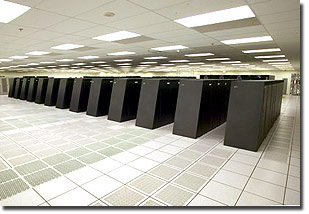Expanded BlueGene/L supercomputer sets new mark and retains rank as world's fastest machine
The National Nuclear Security Administration’s BlueGene/L retained its number one ranking on the new Top500 list of the world’s fastest supercomputers, released today at the international Supercomputing 2007 conference in Reno, Nevada.
Housed in Lawrence Livermore National Laboratory’s Terascale Simulation Facility, BlueGene/L (BGL) clocked 478.2 trillion floating operations per second (teraFLOPS) on LINPACK, the industry standard of measure for high-performance computing. Built by IBM, BGL is a workhorse supercomputer used to make possible science simulation of unprecedented detail for NNSA’s tri-lab Advanced Simulation and Computing (ASC) Program, which leverages the computing expertise and resources of Sandia, Los Alamos and Lawrence Livermore national laboratories.
Computer simulations are a cornerstone of NNSA’s program to ensure the safety, security and reliability of the nation’s nuclear deterrent without underground testing – stockpile stewardship.
Recently expanded to accommodate growing demand for high-performance systems able to run the most complex nuclear weapons science calculations, BGL now has a peak speed of 596 teraFLOPS. In partnership with IBM, the machine was scaled up from 65,536 to 106,496 nodes in five rows of racks; the 40,960 new nodes have double the memory of those installed in the original machine.
“Expanding the BGL system allows us to explore a new class of applications important to our mission and is an important step toward the predictive, fully integrated 3D weapons calculations vital to NNSA’s stockpile stewardship mission,” said Michel McCoy, head of the Advanced Simulation and Computingprogram at Livermore.
Since the expansion of the machine was completed in September, Los Alamos scientists have run atomistic simulations of shock ejecta from copper, a fragmentation and atomization process that is very difficult to study experimentally. LLNL scientists have performed micron-scale atomistic simulations of a Kelvin-Helmholtz instability at a copper aluminum interface in both two and three dimensions. These studies will scientifically establish the connection between atomistic behavior and practical issues in stockpile stewardship.
The upgrading of BGL, notably through the addition of nodes with twice the memory, allows scientists from the three nuclear weapons labs to develop and explore a broader set of applications than the single package weapons science oriented work that has been the mainstay of the machine in the past. For example, BGL had been used widely for materials science calculations such as assessing materials at extreme temperatures and pressures. Now it will be much easier to run more complex applications related to modeling integrated systems as opposed to focused exploration of one area of physics or chemistry.
Groundbreaking calculations have, over the last two years, delivered numerous milestones for the Stockpile Stewardship Program and garnered three Gordon Bell Prizes, widely regarded in the computing community as the Oscars of high performance computing.
Simulations conducted on BGL helped answer critical questions about plutonium aging – a key to understanding the life expectancy of nuclear weapons.
Simulations on BGL of high explosives, super-ionic water, and graphite to diamond experiments have provided scientific insights and/or confirmed results of earlier physical experiments. Scientists used BG/L to perform the first instability simulation with a Reynolds number large enough to determine the nature of turbulence beyond the mixing transition, a feat that made the cover of Nature Physics magazine in August 2006.
The Top500 list is updated and released twice a year; at the June International Supercomputing Conference (ISC) in Germany and at the November Supercomputing (SC) held at different locations in the US. For more information about supercomputer rankings and trends, check the Top500: http://www.top500.org/.
Information about NNSA’s ASC program is available at: http://www.llnl.gov/asc/
Founded in 1952, Lawrence Livermore National Laboratory has a mission to ensure national security and to apply science and technology to the important issues of our time. Lawrence Livermore National Laboratory is managed by Lawrence Livermore National Security, LLC for the U.S. Department of Energy’s National Nuclear Security Administration.
Contact
Don Johnston[email protected]
925-423-4902
Related Links
Advanced Simulation & Computing programBlueGene/L photos
Top500 list
Reynolds number effects on Rayleigh-Taylor instability with possible implications for type Ia supernovae
Keeping An Eye On the Prize





